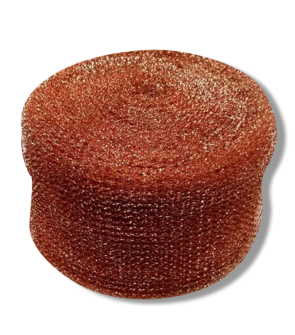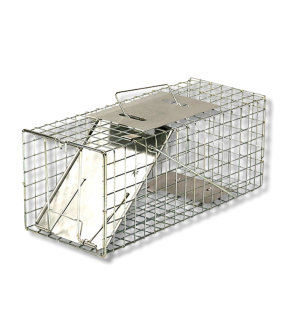How to Catch a Skunk with a Live Trap
Most Effective Products
How to Catch a Skunk with a Live Trap
Skunks are animals that should be taken care of quickly once you notice activity on your property. These animals can potentially carry diseases such as rabies, and their smelly spray won't be easy to remove from your skin or clothing. One method of removing a skunk from your property is using a live trap to catch and release the animal. Live trapping is a safe and effective way to keep animals away from your home.
If you want to catch a skunk with a live trap, read this guide for instructions and product recommendations.
Identification

Before using a live trap, you need to make sure that the wild animal you are dealing with is a skunk. This will ensure that you are using the correct bait and strategies.
Skunks are generally 20 to 30 inches long. They are known mainly for the striped black and white fur and bushy tail. They normally weigh between 6 and 10 pounds and tend to make their homes close to a body of water. Skunks are nocturnal and have a great sense of both smell and hearing. A skunk's spray can reach up to 10 feet, so take caution when approaching or handling this animal.
Use the image and description above to confirm that you are dealing with a skunk on your property.
Inspection

Once you've confirmed that your pest animal is a skunk, it is helpful to recognize the areas where it is most active. This is where you will place your live trap.
Where to Inspect
You want to pick areas that have high activity from skunks. These animals are incredible diggers and may be ruining your garden or lawn looking fro earthworms or insects. Keep an eye out for overturned soil. There might be holes along the foundation as well for skunk burrows.
What to Look For
Because skunks are nocturnal animals, any damage will be done at night. There are certain signs that signal skunk activity, such as damaged gardens, holes in your lawn and under your property, and skunk tracks. These tracks will have five digits on all four of their paws with long nails.
Treatment
Now that you have identified your pest animal as a skunk and taken note of areas where it is most active, you can use your live trap. Be sure to wear gloves when handling the trap to prevent leaving the scent. If a skunk picks up a human scent on the trap, it will avoid the trap, which will make it ineffective.
Step 1 - Remove Food and Shelter Sources

You want the skunk to enter the live trap with the help of bait. Because of this, competing food sources need to be removed. Keep your trash sealed in trash bags and stored in trash bins with a lid to keep it closed. Any fallen fruits or seeds should be picked up and debris should be swept and removed. This will ensure that skunks will have no material to consume or use as a living space.
Step 2 - Place the Trap

By now, you should have taken note of areas with high skunk activity. These areas are where you will put your trap. Be sure to place your trap on an even surface. A skunk might push or knock over the trap in order to reach the bait inside. Place a brick or weight on top of the trap to avoid this.
Step 3 - Bait and Set the Trap

Using the proper bait will increase your chances of catching a skunk. These animals prefer sweet foods such as honey buns with the wrapper open or half of a mashed banana. The bait should be placed near the back of the trap. This ensures that the skunk will need to step on the trigger plate in order to reach the food.
You will then set your trap by pushing on the door lock and lifting the door plate. Keep the door plate lifted while pulling the trigger arm forward to set it. You will know it is set when the trigger arm's hook catches the door.
Step 4 - Monitor the Trap

You will need to check the traps twice a day, preferably once in the morning and once in the evening. This is when you will refill bait if needed. Checking the trap frequently may dissuade skunks from approaching the trap. Do not keep an animal trapped in the cage for longer than 24 hours.
Step 5 - Relocate the Skunk
Any non-target animals should be released immediately. Once you have captured a skunk in your live trap, check your local authorities to make sure you are correctly relocating the animal. Approach the trap slowly and use a gentle voice. Place a towel over the cage to avoid frightening the skunk. Once you have relocated far enough, carefully open the trap and release the animal. You can read more about releasing an animal from a live trap here.
Prevention
After using your live trap, you want to make sure that wild animals do not invade your property again. You can take some preventative measures to keep your area skunk-free.
Sanitation

Keeping trash out in the open is an invitation for a skunk. Be sure to place all waste in a trash can, preferably with a lid so it can be kept closed. Remove all clutter and debris from your property, since skunks may be drawn to nest and burrow in these areas. Any fallen fruit or seeds should be picked up and removed promptly as well.
Exclusion
To avoid skunks from burrowing under your property, be sure to check the foundation for cracks and crevices. These can be sealed with Stuf-Fit Copper Mesh and caulk. Stuf-Fit is a breathable material that many animals cannot chew through. It will not rust and can be stuffed into cracks and crevices before sealing with caulk. Repair any voids or openings around the home or structure, such as damaged screens around windows or basement wells, and damaged or dilapidated fences.
Key Takeaways
- Skunks are nocturnal animals. They have black and white striped fur and a bushy tail. If it feels threatened, the skunk will give many warning signs such as growling before spraying.
- Bait the live trap with sweet food like a honey bun or half a mashed banana, making sure it is placed behind the trigger plate of the trap.
- Check the trap once in the morning and once in the evening. Once a skunk is caught, check with your local authorities to make sure you safely and correctly release it.
- Prevent skunks from entering your property again by removing any potential food sources and trash, as well as sealing any cracks and crevices with Stuf-Fit Copper Mesh and caulk.












































































































































































































































































































































































































































































































































